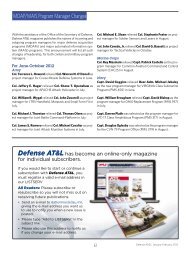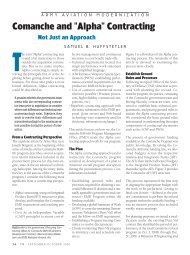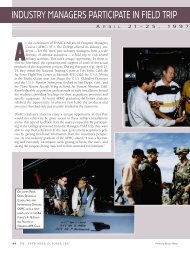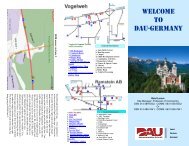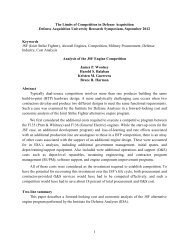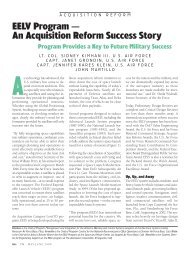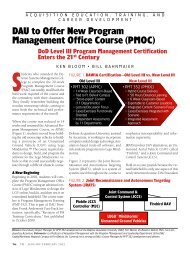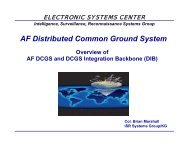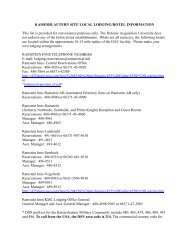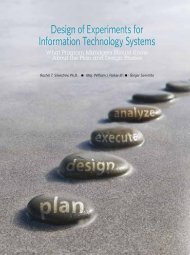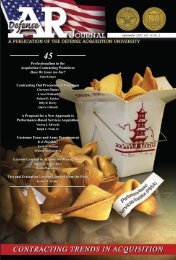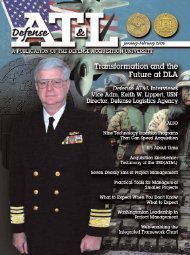Defense ARJ - Defense Acquisition University
Defense ARJ - Defense Acquisition University
Defense ARJ - Defense Acquisition University
You also want an ePaper? Increase the reach of your titles
YUMPU automatically turns print PDFs into web optimized ePapers that Google loves.
systeM of systeMs DeVeloPMent<br />
searchers who study System of Systems Engineering raise serious questions about<br />
this position. These experts believe that the immaturity of SoSE warrants reexamination<br />
of basic assumptions regarding the ability of SE to underpin SoS development.<br />
systeMs enGineerinG: utility anD future aPPlicaBility to an sos<br />
Because the discipline of Systems Engineering is central to defense acquisition,<br />
adherents are enthusiastic about its continued validity for SoSE. Deep commitment to<br />
SE principles is reflected in high-level direction that requires all acquisition programs<br />
to be “managed through the application of a systems engineering approach” (OSD,<br />
2003, p. 7). The <strong>Defense</strong> <strong>Acquisition</strong> Guidebook (DAG, 2006) fleshes out this mandate,<br />
providing a chapter dedicated entirely to SE.<br />
In its SE chapter, the DAG (2006) recommends a “robust systems engineering<br />
approach” for all programs “regardless of acquisition category” (p. 21). To facilitate<br />
this, the DAG details SE’s best practices, providing guidance on technical and management<br />
processes to be applied throughout a program’s life cycle. This wholesale<br />
confidence results from decades of successful application of SE principles in developing<br />
systems of staggering complexity.<br />
Having demonstrated enormous utility for complex development efforts, SE<br />
seems ideally suited for the interconnected systems envisioned for the future. Thus,<br />
the DAG’s (2006) recommendation of SE for SoS development is unsurprising:<br />
“Systems of systems should be treated and managed as a system in their own right,<br />
and should therefore be subject to the same systems engineering processes and best<br />
practices as applied to individual systems,” (p. 100).<br />
The Under Secretary of <strong>Defense</strong> for <strong>Acquisition</strong>, Technology and Logistics<br />
(USD[AT&L]) underscores this guidance in a policy memo specifically addressing<br />
SE’s central role for SoSE efforts:<br />
Application of rigorous systems engineering discipline is paramount….<br />
This is especially true as we strive to integrate increasingly<br />
complex systems in a family-of-systems, system-of-systems context.<br />
Systems engineering provides the integrating technical processes<br />
to define and balance system performance, cost, schedule, and risk<br />
(Wynne, 2004).<br />
However, the <strong>Defense</strong> Department’s ability to apply SE to complex systems has<br />
come under scrutiny in recent studies (DoD JDCST, 2004; DAPA Report, 2006). The<br />
DAG (2006) acknowledges some unique SoS development challenges, calling attention<br />
to factors such as “greater complexity of integration efforts” and “engineering<br />
under the condition of uncertainty” (p. 100). While these viewpoints reveal a budding<br />
understanding of the inherent difficulties in SoS development, the challenges associated<br />
with SoS implementation may be more daunting than currently appreciated by<br />
acquisition professionals.<br />
181



